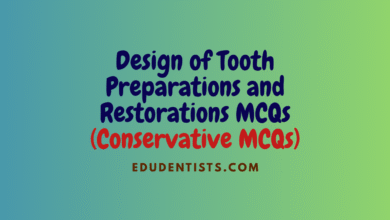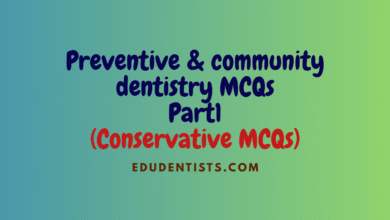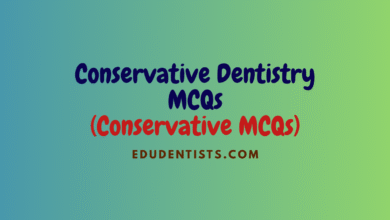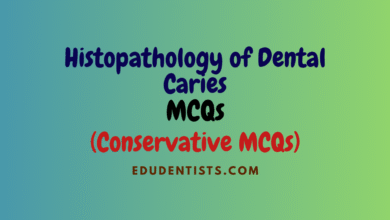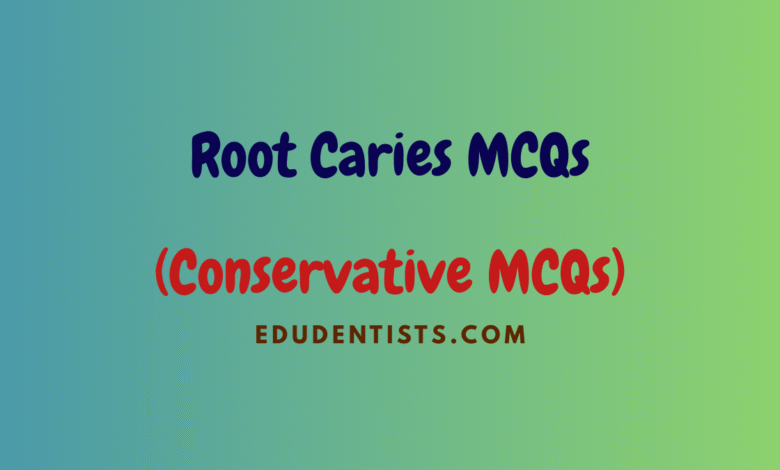
Root Caries MCQs
👉Root Caries: Overview and Management Lecture
1. Root caries is defined as:
A) A soft, progressive lesion on exposed root surfaces ✓
B) Hard enamel cavitation
C) Lesion in pulp only
D) Fracture of crown
2. Root caries typically occurs at or below:
B) Cementoenamel junction (CEJ) ✓
A) Incisal edge
C) Occlusal surface
D) Gingival margin
3. The most common cause of root caries is:
B) Gingival recession ✓
A) Bruxism
C) Deep pits in enamel
D) Trauma
4. Root caries lesions often appear:
A) Discolored compared to surrounding root ✓
B) Same color as enamel
C) White and hard
D) Only black
5. Which teeth are most commonly affected in the mandible?
B) Molars → premolars → canines → incisors ✓
A) Incisors → canines → premolars → molars
C) Canines → premolars → molars → incisors
D) All equally
6. Shape of root caries lesion:
B) Round or oval, may spread radially ✓
A) Triangular with apex toward pulp
C) Cone-shaped toward CEJ
D) Rectangular
7. Root caries is more common in:
B) Males ✓
A) Females
C) Children
D) Only elderly females
8. Root caries can occur as:
A) Primary or recurrent decay ✓
B) Only recurrent decay
C) Only primary caries
D) Only in crowns
9. Root caries may develop at sites of:
A) Abrasion, erosion, or abfraction ✓
B) Only enamel pits
C) Only cervical enamel
D) Only incisal edges
10. Advanced age increases root caries due to:
A) Gingival recession exposing roots ✓
B) Increased enamel thickness
C) Lower sugar intake
D) Less plaque accumulation
11. The main bacteria responsible for root caries include:
B) Streptococcus mutans, Lactobacillus, Actinobacillus ✓
A) Staphylococcus aureus only
C) Candida albicans
D) Pseudomonas
12. Root demineralization occurs at which pH?
A) 6.4 ✓
B) 5.5
C) 4.0
D) 7.0
13. Root demineralization is faster than enamel because:
A) Root has lower mineral content (55%) ✓
B) Root is harder than enamel
C) Enamel contains collagen
D) Root is acid-resistant
14. Which intraoral factor contributes to root caries?
B) Xerostomia ✓
A) Daily brushing
C) Normal saliva flow
D) Regular fluoride use
15. Low salivary buffer capacity leads to:
A) Increased risk of root caries ✓
B) Strong enamel
C) Cementum thickening
D) Pulp necrosis
16. Frequent carbohydrate intake contributes to:
B) Root caries formation ✓
A) Only enamel fracture
C) Gum hypertrophy
D) Oral ulcers
17. Abfraction lesions are a risk factor because they:
A) Make root surface vulnerable ✓
B) Protect dentin
C) Prevent bacterial invasion
D) Increase enamel hardness
18. Extraoral factor increasing root caries risk:
B) Medications reducing salivary flow ✓
A) High fluoride exposure
C) Good oral hygiene
D) Low sugar diet
19. Diabetes contributes to root caries due to:
A) Xerostomia and high sugar environment ✓
B) Strong enamel
C) Increased immunity
D) Cementum thickening
20. Low socioeconomic level is associated with:
B) Higher risk of root caries ✓
A) Lower bacterial count
C) Thicker enamel
D) Reduced gingival recession
👉Root Caries: Overview and Management Lecture
21. Best clinical method to detect root caries:
A) Explorer examination after cleaning ✓
B) Visual inspection without cleaning
C) Bitewing X-ray only
D) Palpation
22. Accurate radiographs are useful but must be:
B) Free from overlap or burnout ✓
A) Taken without film
C) Only periapical
D) Ignored
23. Special dyes help detect root caries by:
A) Staining infected dentin ✓
B) Whitening enamel
C) Highlighting pulp chamber
D) Coloring cementum
24. Active root caries color is usually:
A) Light brown ✓
B) Dark brown or black
C) Black and hard
D) White and hard
25. Arrested root caries color is usually:
B) Dark brown to black ✓
A) Light brown
C) Yellow
D) Transparent
26. Active root caries texture:
A) Soft, leathery, elastic ✓
B) Hard and brittle
C) Smooth and shiny
D) Transparent
27. Arrested root caries texture:
B) Hard, cannot be compressed ✓
A) Soft
C) Leathery
D) Porous
28. Extrinsic stain on root surface is:
B) Hard and rough, dark ✓
A) Soft and brown
C) Elastic
D) Transparent
29. Differential diagnosis between active and arrested caries helps:
A) Determine treatment needs ✓
B) Ignore lesion
C) Extract teeth immediately
D) Only monitor enamel
30. Root surface should be cleaned before examination to:
A) Avoid misdiagnosis due to plaque ✓
B) Bleach the lesion
C) Harden root caries
D) Detect enamel only
31. Main preventive strategy for root caries:
A) Plaque control, fluoride, diet modification ✓
B) Extraction
C) Only restorative treatment
D) Ignore mild lesions
32. Patients with low saliva can benefit from:
B) Xylitol chewing gum ✓
A) Hard candies
C) Alcohol rinses
D) Acidic beverages
33. Root caries lesions are difficult to restore because:
A) Subgingival location ✓
B) They are superficial
C) Only enamel affected
D) No bacteria present
34. Before restoration, root surface should be:
A) Cleaned with pumice ✓
B) Only rinsed
C) Coated with fluoride
D) Left untouched
35. For composite restoration of root caries:
B) Coronal margins should be beveled ✓
A) Retention grooves occlusally only
C) No preparation needed
D) Enamel etched only
36. Gold restorations require:
A) Retention grooves occlusally & gingivally ✓
B) No preparation
C) Only surface polish
D) Beveling coronal margins
37. Glass-ionomer cement is preferred for root caries because:
B) Fluoride release and chemical bond ✓
A) Aesthetic superiority
C) No bond to tooth
D) No fluoride release
38. Microfilled composites are suitable because:
A) Flexible and accommodate tooth flexion ✓
B) Hard and brittle
C) Only bond to enamel
D) Do not adhere to dentin
39. Key factor in selecting restorative material:
B) Location, access, margins, oral hygiene ✓
A) Patient age only
C) Tooth color only
D) Plaque only
40. Prevention in prosthesis-wearing patients includes:
A) Proper tissue management & avoiding subgingival margins ✓
B) Avoid fluoride
C) Ignore plaque
D) Extract adjacent teeth

